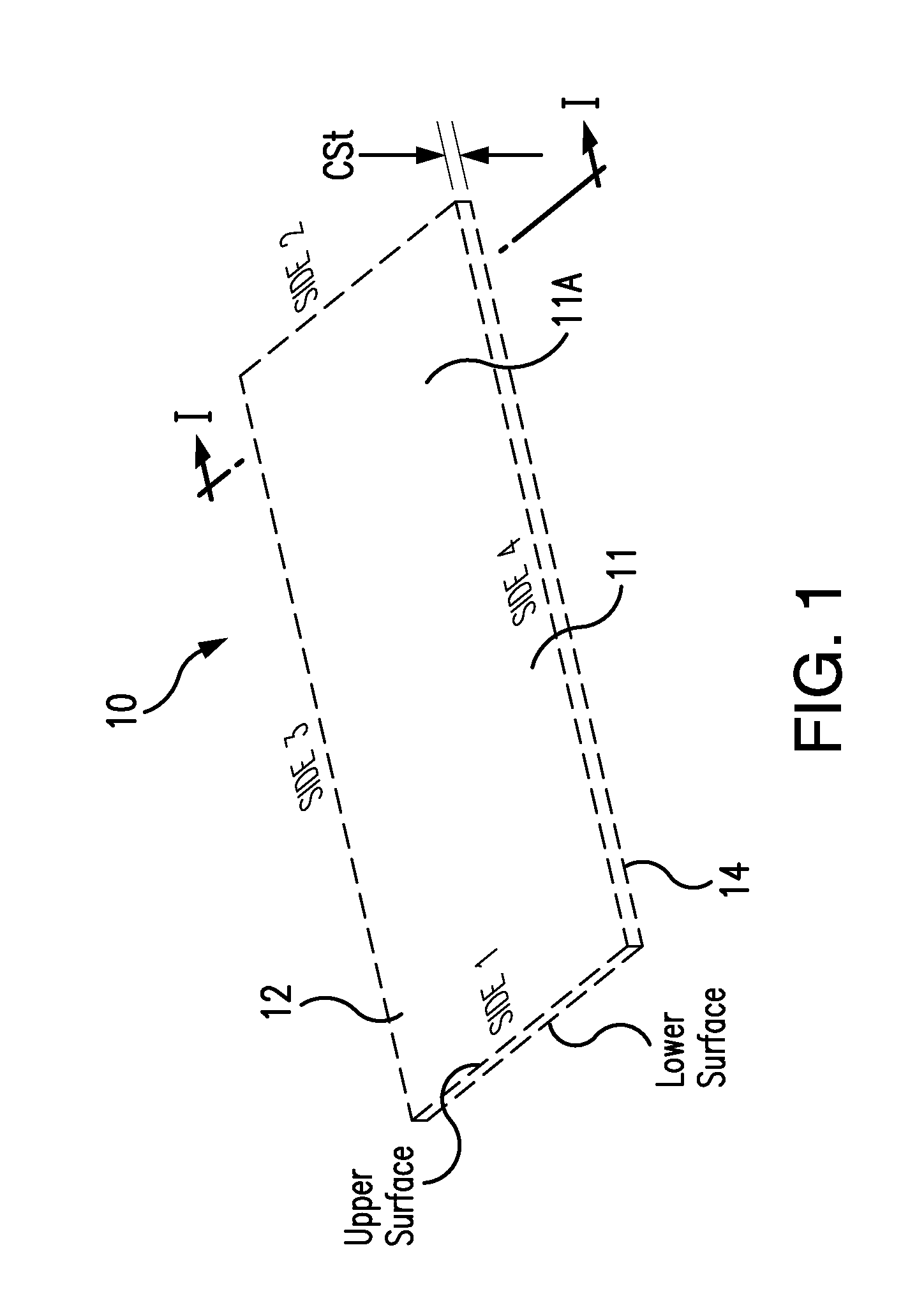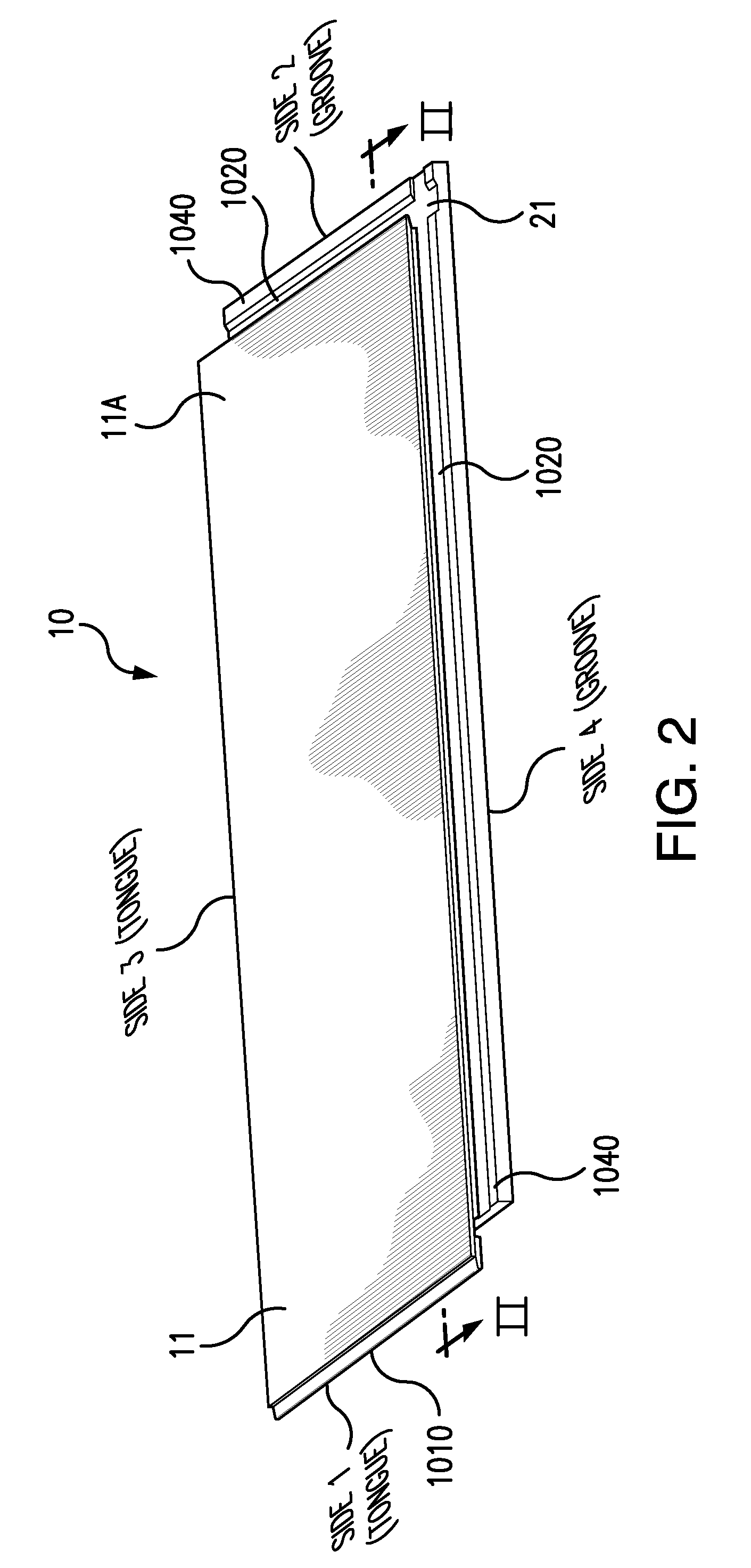Floor covering with interlocking design
a technology of interlocking design and floor covering, which is applied in the field of surface coverings, can solve the problems of high adhesive cost, high installation cost, and high installation cost of full-spread adhesive, and achieve the effects of high adhesive cost, high adhesive cost, and high installation cos
- Summary
- Abstract
- Description
- Claims
- Application Information
AI Technical Summary
Benefits of technology
Problems solved by technology
Method used
Image
Examples
example 1
[0296]Various floor planks of the present invention were made having a square edge design such as illustrated in FIG. 16.
[0297]The formulations are set forth in Tables 1 and 2 below. An LVT design is illustrated in this example. The plank is formed as two sheets with two base layers provided in a first sheet and a third base layer used as a second sheet that is consolidated with the first sheet in forming the plank. Rectangular shaped pieces with flat edges on all four sides having the dimensions, or slightly larger dimensions, as indicated for planks 1 and 2 in Table 1 are punched out from the consolidated sheet.
[0298]Planks formed with these formulations and constructions are milled to have edge profiles on the width and longitudinal sides have tongue and groove profiles such as shown in FIG. 16 herein, wherein Tg=0.061 inch, H=0.037 inch, Tt=0.054 inch, Tt′=0.089 inch, H′=0.037 inch, Tg / Tt′=0.685, CSt=0.158 inch (4.0 mm), TL=0.270 inch, and TL / CSt=1.71. Equipment for imparting th...
example 2
[0305]A floor plank of the present invention was made having the square edge design such as illustrated in FIG. 37.
[0306]The formulation is set forth in Tables 3 and 4 below. A VCT design is illustrated in this example. The plank is formed as a single sheet. Rectangular shaped pieces with flat edges on all four sides having the dimensions, or slightly larger dimensions, as indicated for planks 3 and 4 in Table 3 are punched out from the consolidated sheet.
[0307]Planks formed with these formulations and constructions are milled to have edge profiles on the width and longitudinal sides have tongue and groove profiles such as shown in FIG. 37 herein, wherein CSt=0.122 inch (3.1 mm), Tg=0.041 in., Tg(maximum)=0.048 in., H=0.037 in., Dg=0.015 in., angle θ=28°, θ5=30.29°, angle α2=2.29°, angle α3=2.00°, angle α5=5.00°, angle β=63.10°, G1=0.274 in., G4=0.085 in., G6=0.080 in., G7=0.052 in., H=0.037 in., Tt=0.040 in., Tt′=0.073 in., Tg / Tt′=0.56, H′=0.037 in., TL=0.337 in., TL / CSt=2.76, T1=0...
example 3
[0313]Non-grouted VCT floor tiles were made as 3 mm (CSt) tiles, which had the profiled edge design and dimensions shown in FIG. 12 and described herein. For these tiles, the VCT material was modified to include a higher level of vinyl material in the composition than the formulation shown in Example 2, and were punched into 16 inch×16 inch square-shaped tiles in one production run, and 12 inch×12 inch square-shaped tiles in another production run, but otherwise the manufacture of the tiles was substantially similar to that described for the VCT material of Example 2.
[0314]The formulation of the VCT material used for this example is shown in Table 5. All component amounts indicated in Table 5 are weight percentages.
[0315]
TABLE 5FormulationSingle BaseLayer, amt.Ingredientsin wt %.PVC25%-28%Plasticizer10%-23%Filler55%-80%Stabilizer1%-3%Pigments0.1%-2%
[0316]The tile products were easily installable and formed strong joints. The floor tiles had the properties previously described.
PUM
| Property | Measurement | Unit |
|---|---|---|
| length | aaaaa | aaaaa |
| length | aaaaa | aaaaa |
| width | aaaaa | aaaaa |
Abstract
Description
Claims
Application Information
 Login to View More
Login to View More - R&D
- Intellectual Property
- Life Sciences
- Materials
- Tech Scout
- Unparalleled Data Quality
- Higher Quality Content
- 60% Fewer Hallucinations
Browse by: Latest US Patents, China's latest patents, Technical Efficacy Thesaurus, Application Domain, Technology Topic, Popular Technical Reports.
© 2025 PatSnap. All rights reserved.Legal|Privacy policy|Modern Slavery Act Transparency Statement|Sitemap|About US| Contact US: help@patsnap.com



